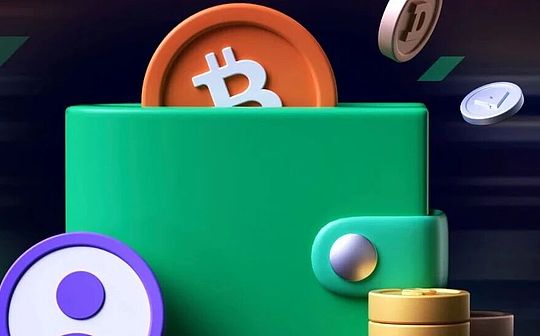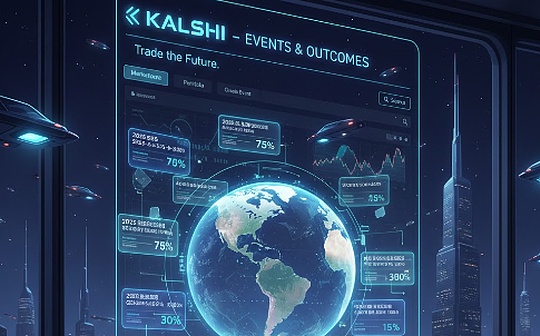
Author: Bib Exchange
I believe you have seen a project EIGENLAYER recently.What kind of project is this?I believe everyone knows more or less.In this article, Bib Exchange will comprehensively interpret this new project that makes Ethereum love and hate -EIGENLAYER.
EIGENLAYER is a token economic security lease market platform. The main services include RESTAKE, node operation pledge and AVS services for LSD assets.Eigenlayer is a RESTAKE protocol based on Ethereum, providing Ethereum -level security for the entire future -based encrypted economy.It allows users to redefine through Eigenlayer smart contracts to redefine the native ETH, LSDETH and LP Token and get verification rewards to allow third -party projects to receive more rewards while enjoying ETH’s main network security, thereby achieving a win -win situation.
1. Principle
1.1 Speaking from a virtual machine
Ethereum conceived in 2013 and launched in 2015. By introducing the Ethereum virtual machine (EVM), it completely changed the blockchain pattern.Ethereum created a programmable concept, enabling distributed applications (DAPP) to build it without licenses on it.This innovation makes DAPP developers do not need to be trusted, because security and activity are guaranteed by the underlying blockchain, and trust is provided by the blockchain.
This decourse innovation has greatly promoted the development of anonymous economy, because innovators do not need reputation or trust, DAPP can be used by any trusted person, and the underlying blockchain can verify the code of DAPP.Value stream provides trust to DAPP through the blockchain and charges fees with exchange.With the development of the Layer2 era, its scale has expanded significantly.Rollup outsourcing is executed to a single node or a small group of nodes, and the EVM contract can be used to absorb the trust of Ethereum through Ethereum Calculation.
>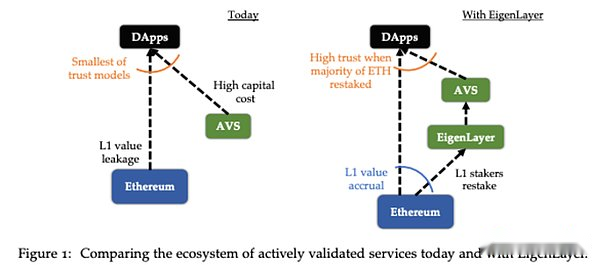
However, the traditional verification service obviously lacks a trust mechanism.Any module that cannot deploy or proves on the Ethereum virtual machine (EVM) cannot absorb the collection trust of Ethereum.These modules involve input from Ethereum, so their processing cannot be verified in protocols inside Ethereum.
The examples of these modules include side chains, data availability layers, new virtual machines, management networks, prophetic machines, cross -chain bridges, retarded cryptographic schemes, and trusted execution environments based on new consensus protocols, new virtual machines, management networks, prophetic machines, cross -chain bridges, client password schemes.These modules need to actively verify services, and they have their own distributed verification semantics for verification.Usually, these active verification services (AVS) are either protected by their own native token or a permission.
1.2 AVS
Eigenlayer directly connects the safety and liquidity of Ethereum, and AVS plays a vital role here.AVS (Actively Validated Services, Active Verification Services) usually refers to a service that verifies individual identity or specific information.AVS can be applied to multiple fields, such as finance, telecommunications, online services, etc. to ensure that the information provided is accurate, effective and legal.
Therefore, the essence of EIGENLAYER is to entrust various middleware, data availability layers, side chains, prophecy machines, sorters, etc. The safety verification of the Ethereum -level safety demand project is entrusted to the node operator of Ethereum, thisThe process is called RESTAKE.EIGENDA is a decentralized data availability (DA) service built on Ethereum with Eigenlayer Restake, and it will be the first active verification service (AVS) layer.
1.3 Business logic
Eigenlayer’s business logic involves multiple key concepts, including middleware, LSD, AVS, and DA layers.These concepts interweave each other, constitute the complex and specific business logic of Eigenlayer.EIGENLAYER has effectively output ETH’s security to the entire Ethereum ecosystem through its business logic, especially node operation, AVS service and other functions.Through the provision and pledge of LSD (LIquid Staking Derivatives) assets, users provide additional security support for Ethereum network.
>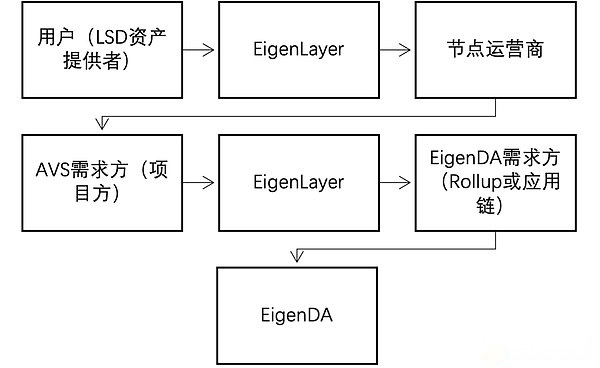
According to the figure, we can simply combine business logic:
i. LSD asset provider: Users can get additional benefits to node operators by providing AVS services for node operators by holding tokens such as EIGENLAYER to provide EITETH, RETH, CBETH, and other tokens to obtain additional benefits.
II. Node operator: Obtain LSD assets through Eigenlayer, provide node services for the project party who needs AVS services, and get node rewards and handling fees from the project party.
III. AVS Demand (Project Party): The project party purchases AVS services through Eigenlayer, and does not need to build an AVS to reduce costs.
Iv. EIGENDA demand party (Rollup or application chain): Rollup or application chain can obtain data availability services through EIGENDA.
v. Eigenlayer’s role: The main role of Eigenlayer is to reduce the cost of building a trust network independently, expand the use scenario of ETHLSD, improve the capital efficiency and income of LSD assets, and increase the demand for ETH.
1.4 The relationship between the participants
At the same time, we can see the participants in this piece as follows: We can see that the role of eigenlayer in the block according to the official white paper is as shown in the figure::
>
So the relationship between the main participants in this is as follows:
>
-
LSD asset provider: I hope to obtain additional benefits and be willing to provide LSD assets as pledge to node operators.
-
Node operator: Get LSD assets from Eigenlayer, provide AVS services for the project, and get node rewards and handling fees.
-
AVS demand party: The project party needs AVS services, purchased through Eigenlayer without the need to build an AVS.
-
EIGENDA demand party: Rollup or application chain requires data availability services.
Second, worry about DA from L2
The 11th AMA focus of the Ethereum Foundation Research Team discussed how to do EIP-4844 and how Ethereum will solve the liquidity fragments and combined problems on L2.This is also what V God has always wanted to emphasize.
>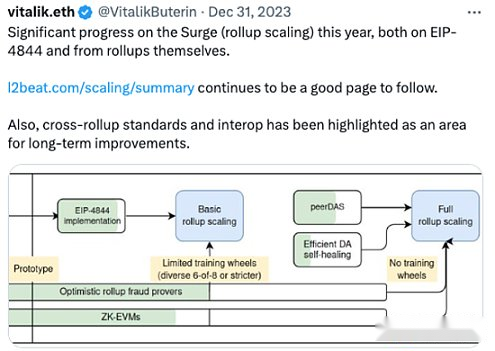
This is the biggest test facing Ethereum.What if Layer2 does not do?Choose Ethereum as a DA, or is it else?However, it can be felt that Ethereum is also helpless, and may face the competition of Celestia. Once other L2 does not use Ethereum to do DA, Ethereum may “fall out slowly.”Therefore, Ethereum should promote the upgrade of Cancun as soon as possible to reduce the cost of Layer2.
Vitalik said: “The key to rollup is unconditional security: even if you are targeted by everyone, you can still take assets. If DA depends on external systems (outside Ethereum), this cannot be done.”
Regarding the above sentence, some people questioned that V God was based on the logic of the Ethereum main network and did not get out of the framework.At the same time, a similar point of view appears on the market -Layer2 is not to publish DA data to Ethereum in order to avoid the sorter of “data detention”, which can be placed on other similar Celestia third -party DA.
We can distribute the four important levels of the external system of ETH through the figure below.
>
Therefore, a large feature of Cancan upgraded a large feature focused on EIP-4844. After the completion, the entire node of Ethereum will automatically lose some historical data, so that the historical data of Layer2 over 18 days will no longer be backup by the ETH node.Examination will no longer be close to Trustless as today.Earlier, users can prove their Layer2 asset status through Merkle Proof to achieve unnecessary withdrawal on Layer1.
2.1 Data usability
First of all, let’s take a look at what kind of structure of Celestia’s DA?
Quantum Gravity Bridge is an Ethereum Layer 2 solution. Through the data availability (DA) verification provided by Celestia, it greatly reduces the cost of storing DA on the main chain of Ethereum.The specific process includes L2 Operator to publish the transaction data to the Celestia main chain, and Celestia authentication signs the Merkle Root of DA Attestation to the DA Bridge Contract verification and storage on the main chain of Ethereum.The Celestia chain implements the consistency of Data Blob on the P2P network and Tendermint, but the whole node has higher requirements for high -speed download and uploading, and the actual throughput is relatively low.Celestia’s Quantum Grality Bridge guarantees the availability of data while reducing costs.
>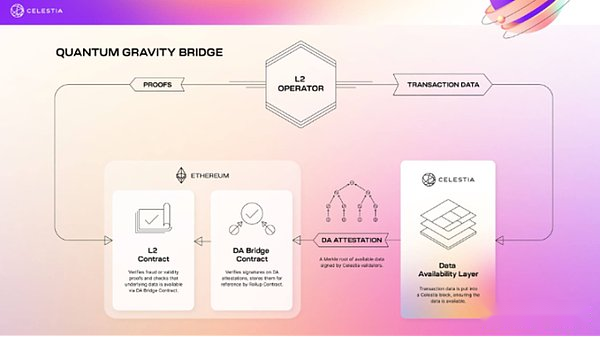
At this time, EigenLayer, as a platform, is essentially committed to the security of Ethereum (ETH) in its core, and has made important innovation in data availability (DA).By introducing the new data structure of BLOB space, it iterates the restrictions on relying on CALLDATA to store data in the past, and at the same time enhances the Data Availivity capabilities of the Ethereum main network.Pure Rollup refers to a solution that simply puts DA on the chain, that is, you need to pay 16 GAS for each byte of constant payment, which will account for 80% -95% of the Rollup cost.After introducing Danksharding, the cost of DA on the chain will be greatly reduced.
Compared with the full node storage structure of CallData, BLOB is designed as a temporary storage of some nodes. This can greatly increase the data limit submitted by LAYER2 to the main network, which can expand its TPS. At the same time, due to temporary storage, the data storage efficiency will be improved.Data storage costs also declined straight.The improvement of DA capabilities is more than enough to deal with OP-Rollup’s 7-day fraudulent time window because of temporary storage of 1 month.
The transaction volume submitted by Layer2 to the main network will increase significantly, and the cost of a single user will also decrease significantly.No matter how high Layer2 brags about Layer2 before the upgrade, most of them are the test environment. Instead, the bad experience of GAS’s wear that users intuitively feels intuitively makes everyone feel that Layer’s2 is not true.
2.2 Centralization problem
The decentralization problem of Sequence has always been the focus of the market. As a result, everyone found that the strong OP Rollup on the Layer2 track, decentralized Sequencer has become the alliance’s social consensus “soft decentralization”.
Layer2 decentralized Sequencer solution provider Metis’s TVL locking amount has ranked third in L2.The problem of decentralization of Sequence is related to the credibility of Layer2 to submit transactions, and it also has the problem of main network interaction security issues of Layer2 transactions.It seems that all of the “air tower”, the decentralization problem of Sequence always has other breakthroughs.
2.3 Layer2 gradually modularized, orthodox will be broken
When the Layer2 market is as large as a certain scale, the orthodoxity of the Pacific Layer2 may be broken. After the upgrade of the Cancun, the third -party DA solution will invade Layer2, including the third -party DA solution mentioned in the Celestia earlier.
The focus of the OP Stack stack implementation is to realize the sharing of Sequencer. The focus of the ZK Stack stack is to realize the shared Prover system, its own DA capabilities and third -party DA capabilities such as CELESTIA, and the limited DA capabilities of the main network, which will belong to the strategic circle of ZKScope.
2.4 EIGENLAYER provides DA
So at this time Eigenlayer came forward.Given that many ecological applications are currently deployed on Layer 2, their smart contracts need to conduct data interaction or obtain data availability services with EIGENLAYER.The integrated Layer2 solution includes the complex products from the CELO, Mantle and BitDao ecosystems from L1 to Ethernet L2, providing FLUENT offering ZKWASM execution layers; offShore on the MOVE execution layer; and OP Stack of Optimism. CurrentlyUse on the EIGENDA test network.
EIGENDA is a common DA solution, which is the same category as Celestia and Polygon Avail.But there are some differences between EIGENDA and the remaining two.Eigenlayer has carried out unique reconstruction in terms of data availability and created a new data availability model.By introducing AVS services, the project party can obtain the required services without self -built AVS.This innovation not only reduces the cost of the project party, but also provides more efficient and scalable data availability solutions for the entire Ethereum ecosystem.Eigenlayer’s innovation in this field brings new possibilities for the development of the blockchain ecosystem.
3. Competition and challenge
3.1 Polygon+Celestia competition
Competition not only comes from the inside, but also outside. Polygon+Celestia has begun to compete with Ethereum. In the past 18 months, the outbreak of Rollup technology has largely allowed senior users in the DEFI field to experience unprecedented user experience, includingFast confirmation speed and cheaper trading
Polygon’s custom development tool package (CDK), which can quickly develop modular blockchain.The modular method of CDK allows developers to choose specific components to realize the personalized design of blockchain examples, and to realize the interoperability between each blockchain through interconnection.The four main parts of Polygon CDK include ZK Proveers, data availability, virtual machine (VM) and sorters.The combination of these parts provides developers with the right to choose, so that they can flexibly build blockchain according to the project needs.
>
Celestia and Polygon Labs announced that the data availability layer of Celestia integrated with Polygon CDK.This cooperation will further improve the efficiency of Ethereum L2 transactions and reduce transaction costs.Defi users will experience a better user experience.The integration with CeleStia is expected to greatly reduce the Ethereum L2 transaction cost, so that users will trade in a better execution environment, and the cost may be less than $ 0.01.
3.2 The ambiguity of cosmos
The liquidity and combined fragmentation of crossing Rollup (more generally cross L2, including verification) is a problem.Each rollup (such as ARB or Optimism) is an execution of “tube warehouse”: isolation pre -confirmation, isolation sorting, isolated state, and isolation settlement.The universal synchronization of the Ethereum contract has been lost, which is the basic driving force of the network effect.
RecentMany innovations of COSMOS involve the use of authentication sets to perform supplementary work.However, maintaining the legal number of verifications with strong economic security is a well -known challenge.EIGENLAYER solves this problem by providing economic equity platforms -allows any equity holders to contribute to any POS network.By reducing costs and complexity, EIGENLAYER effectively paved the way for the innovation in the L2 tapping of the COSMOS stack.
COSMOS is mainly based on its modular nature, which will operate, that is, the shortcomings of Taifang, centered on the ecosystem, and realize the interoperability between independent blockchains through the Tendermint consensus and IBC protocol.Use Tendermint to reach consensus and execute transactions.The integration simplifies the development of the blockchain and provides a cohesive environment, but it may limit the flexibility that meets the needs of different applications.
>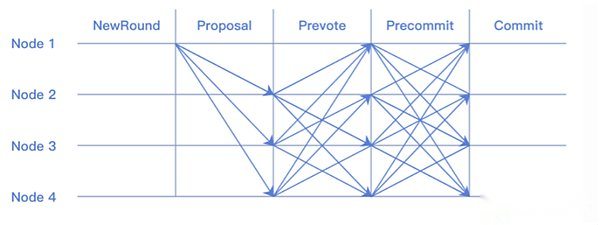
Through the Tendermint’s integrated icon (if it is not well understood, it can be understood as the Byzantine protocol), it forms a interconnected blockchain network, running under the protection of COSMOS, emphasizing the collaboration and interaction between the blockchain.Therefore, COSMOS launched an application -specific innovation is a perfect supplement to the complex pledge community and capital foundation of Eigenlayer.Therefore, it is expected that deeper cooperation is highly creative, expands the function of Ethereum, and creates the environment for COSMOS builders, and uses their talents to the world’s largest chain -programmable pledge economy.
Ethereum and COSMOS initially pursued different goals, but their technological development gradually converged.Both are facing common technical challenges, such as MEV, liquidity fragmentation and extensive decentralization.COSMOS is continuously developed as an experimental link, while Ethereum is verified as a combined settlement layer.Until the emergence of Eigenlayer.EIGENLAYER solves this problem by providing economic equity platforms -allows any equity holders to contribute to any POS network.By reducing costs and complexity, Eigenlayer effectively paved the way for the expression innovation in the COSMOS stack to excavate L2.
MEV (maximum extraction value) has always been a core issue that Ethereum is concerned, which has a profound impact on future roadmaps and protocol design.In order to cope with the concentrated pressure caused by MEV, Ethereum uses the method of separation of proposal builders (PBS).In Ethereum, PBS is currently implemented through the MEV -BOOST protocol design. The design uses a credible submission -display solution.Ethereum plans to integrate a fixed PBS (EPBS) design to the basic layer to eliminate the dependence on trusted third parties and achieve a more decentralized PBS.
In COSMOS, it is also facing MEV problems, and in order to solve this problem, it is implementing a more advanced EPBS solution.For example, OSMOSIS is experimenting with the mechanism of arbitrage profit sharing, and SKIP is testing the Block SDK, which is a decentralized block builder and proposal committed design.The separation of each component in the blockchain architecture, such as consensus, data availability and execution, compare with traditional integrated blockchain.Modularization allows each component to independently develop, optimize and expand, and provide customized high -efficiency frameworks.The processing of a large amount of data modularization has enhanced scalability and can effectively process large amounts of data. It is particularly suitable for applications that require high -transit throughput requirements.
>
Vitalik Buterin as of December 2021’s Ethereum route map
Eigenlayer introduced a new wave of innovation by connecting Ethereum and COSMOS.The COSMOS community can use Ethereum’s decentralized security and liquidity, and Ethereum can learn from innovation experiments in COSMOS.This fusion brings new possibilities to the two ecosystems.At the technical level, MEV is an important issue for Ethereum and COSMOS, and both are exploring solutions.Mutuality is also a key concern, especially the modular nature of COSMOS.As their design converges, they begin to learn from each other and adopt some of each other’s design elements.
Eigenlayer reduces the obstacles of Ethereum using COSMOS innovation, especially by providing economic equity platforms to enable L2 to use the authentication set to supplement work.This has paved the way to achieve more innovation and cooperation between the two ecosystems.Eigenlayer integrates the technology stack of Ethereum and COSMOS, bringing a symbiotic relationship of unlimited possibilities.This integration can not only promote the development of Ethereum and COSMOS, but also is expected to create more creative and flexible ecosystems.
3.4 Competitive products based on the LSDFI platform
Rivals and partners Restake
The project is based on EIGENLAYER to provide modular liquidity pledge solutions.In an innovative way, users can harvest the pledge rewards of Ethereum and Eigenlayer without locking assets or processing complex infrastructure.Managed by decentralized autonomous organizations (DAO), it mainly focuses on the strategy of income.
>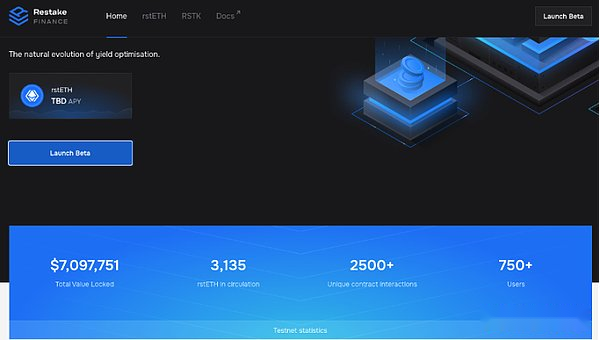
Through the newly launched Rean Etherbult (RSTH), promoting the liquidity re -pledge of LSTS (such as STETH) inside Eigenlayer.It holds the pledge reward of Ethereum and Eigenlayer seamlessly, which is estimated to be between 3% -5% and more than 10%.
Its token RSTK (maximum supply of 100 million) is used for practicality and governance of ecosystems.The success of the success of Eigenlayer is directly related to the income, reflecting the growth of the platform.The cost is fixed to 10%, of which 5% are to the pledged and 5% return to the platform’s treasury.
The project focuses on decentralization and community governance to promote cryptocurrency transactions.Through its unique stake & amp; yield mechanism, RESTAKE provides a considerable income for the holder and realizes the governance through community voting.The project focuses on security and sustainability, providing users with a reliable trading ecosystem.
Prisma Finance
>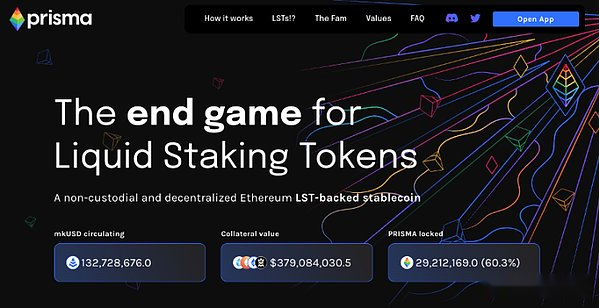
The project focuses on the Ethereum liquidity pledge derivatives.Users can use multiple LSDs (WSTTH, RETH, CBETH, SFRXETH) in full mortgage to cast stable currency MKUSD.A variety of LSD mortgages: WSTTH, RETH, CBETH, and SFRXETH can be used for MKUSD casting.Get LSD returns.Staying in the stability pool can get higher APR.Maintain MKUSD debt extra PRISMA rewards per week.MKUSD is relatively stable assets to provide users with additional income.
Its PRISMA (total supply of 30 million); earning PRISMA methods include saving ponds, casting MKUSD, maintaining MKUSD debt, pledged Curve/Convex LP.Locking PRISMA can earn an agreement fee and increase the voting right, the longest lock -up period is 52 weeks.
Lybra.finance
>
LYBRA is a LSDFI platform that focuses on stabilizing the cryptocurrency market through liquidity pledge derivatives (LSD).
The project provides a unique stablecoin EUSD, supported by ETH assets, and has stable interest for the holder.Using LSD income, users get a stable income of EUSD.At the same time, PEUSD, EUSD’s Omnichain versions increased the choice of liquidity pledged token.Reth and WBeth, as the collateral of EUSD and PEUSD, increased flexibility.
LBR (total supply of 100 million) is ERC-20 token, based on Arbitrum and Ethereum network.The use of tokens includes governance, revenue enhancement and ecological system incentives.ESLBR ESLBR is the LBR of hosting, has the same value, and is limited by the total supply of LBR. It cannot be traded.But the share of voting rights and agreement returns.ESLBR holders actively participate in the direction and development of shaping the Lybra protocol.ESLBR holders obtained 100% of the agreement, increasing their potential income.Compared to the two previous projects, Lybra stood out because he could work across the chain to make it accessible to a larger market.
Fourth, development and prospects
Just like the previous article discussed the DA chapter, at the demand level, Kankun upgraded and the openness of OP Stack prompted small and medium RollUp and the rapid development of the application chain, increasing the demand for low -cost AVS.The demand for a cheap DA layer in the modular trend increases the demand for EIGENLAYER for EIGENDA expansion.At the supply level, Ethereum pledge rate increases and the number of pledged users has increased, and the scale of LSD assets and holders is provided. They have the willingness to improve the efficiency and benefits of LSD assets.
4.1 Product progress
The first is the product progress. To tell the truth about the product page of Eigenlayer itself, it is a bit unsatisfactory, and there is no such user -friendly flexible page.From the perspective of users, users cannot obtain any substantial pledge income in the short term, and the unknown situation of pledge rewards may affect the subsequent rise of the number of users.
EIGENLAYER has established an open market, which can choose whether to join each module and determine which modules are worthy of additional collective security.This provides a free market structure that allows the new blockchain module to use the resource differences between verifications.Therefore, the current pages of the products promoted by the current open market have not been done, and most of them are promoted through the operating angle of the project party.Of course, if you participate in some activities, you can find that the function of RESTAKE is integrated: users can perform RESTAKE such as STETH, RETH, CBETH to participate in the ecosystem of Eigenlayer.
4.2 Business model
The deposit activities of the two LSD assets attracted users, and the deposit quickly reached the limit, and users were interested in potential airdrop rewards.Eigenlayer has accumulated a Staking Eth of about 150,000, and you can see the current TVL on the official website.
>
Eigenlayer’s official website as of January 27, 2024 (5: AM, UTC)
EIGENLAYER mainly collects security service fees for AVS service users, of which 90% are given LSD depositors, 5% to node operators, and EIGENLAYER’s commission ratio is 5%.
4.3 Future Development
Eth pledged on Ethereum is about $ 42 billion, and the scale of funds on the entire chain will be US $ 30-400 billion.The size of the project of EIGENLAYER is expected to be in a short period of $ 10 to 10 billion in the short term.All projects that need tokens to pledge to tokens, maintain network consensus with the game mechanism, and maintain decentralization are potential users.The market’s evaluation of Eigenlayer is quite high. Taking the current 25 times PS of Lido as an anchor point, the new narrative may enjoy a higher premium when it comes on stage, with a value of 20-40 times.We can simply calculate EIGENLAYER’s valuation conservative in the future is also a project of $ 10-20 billion.
Eigenlayer has completed three rounds of financing, with a total of more than 64 million US dollars.Among them, the latest A round financing was led by Blockchain Capital, and Coinbase Ventures, Polychain Capital, iOSG Ventures, etc. participated in the investment, with a valuation of up to 500 million US dollars.It is difficult to accurately estimate the market size, but it may reach 10 billion US dollars within 3 years under optimism.If the market is expected to increase with a compound annual growth rate of 37%, revenue will exceed $ 25 billion by 2030.
5. Risk and challenge
Eigenlayer is also facing challenges such as technical complexity and market adoption of uncertainty.Although Eigenlayer currently occupies an unlikely position in the AVS market, potential competition and additional risks brought by the intermediate parts cannot be ignored.
Re -pledged collective security issues: At present, there is a challenge for re -pledged collective security.EIGENLAYER has established a new mechanism by allowing authentica to use re -pledged tokens instead of its own tokens to obtain security, and the verifier obtains additional income by providing security and verification services.
Open market mechanism problem: Eigenlayer introduced an open market mechanism that allows verifiers to choose whether to join each module and determine which modules are worthy of additional collective security.This selective dynamic governance provides a free market structure for launching new additional functions.
The launch of the new AVS: Innovatives must build a new trust network when starting the new AVS to ensure security, which may be a difficult task.
Value Disclosure: As each AVS develops its own trust pool, users must pay the costs of these pools, which leads to diversified loss of value.
Capital cost burden: Professor to protect the new AVS must bear capital costs, including opportunity costs and price risks.AVS must provide enough mortgage returns to cover this cost, which is a challenge for many AVS.
DAPPS’s trust model is reduced: The current AVS ecosystem has led to a reduction in DAPP’s trust model because applications dependent on specific modules may become attack targets.But the security disadvantages brought by the RESTAKING mechanism may affect the settlement of AVS to a certain extent.
Risk of LSD collateral: The project party uses LSD mortgages as a security pledge need to consider the Credit and security risks of the LSD platform itself, which increases a layer of risk.
Although EIGENLAYER shows the advantages of innovative re -pledge agreements, the risks need to be considered.At the same time, the centralized governance model of Eigenlayer may lead to the lack of control of governance in governance and the slowness of the decision -making process.
Summarize
Eigenlayer’s concept of exporting ETH security emphasizes the interoperability of the blockchain ecosystem.This interoperability helps build a stronger and secure blockchain network, laying a solid foundation for future development.Provide security and trustworthy layers, support a variety of modules, such as consensus protocols, data availability layers, etc.Three -round financing has been completed with a valuation of 500 million US dollars.As an innovation agreement, there is a great opportunity for future development.
In the early days of participating in this project, I believe that you have also learned in major news, social platforms and various KOL recommendations. This article will not be repeated in detail.BIB Exchange believes that Eigenlayer is not only an independent platform, but part of the entire Ethereum network. It is also a unique project that can tap with CELESTIA and Polygon.Of course, there are a lot of critical and questioning voices. This article explains in detail about the relevant principles. It is also hoped that readers and friends will take more initiative to judge and pay more attention to the pledge of the ecology.

